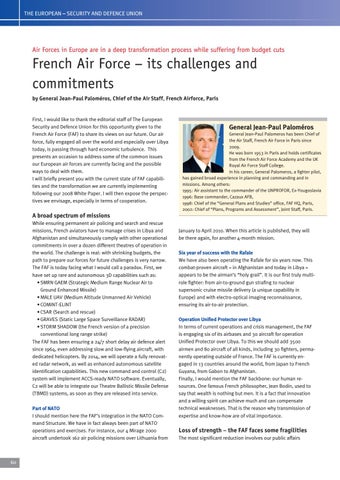THE EUROPEAN – SECURITY AND DEFENCE UNION
Air Forces in Europe are in a deep transformation process while suffering from budget cuts
French Air Force − its challenges and commitments by General Jean-Paul Paloméros, Chief of the Air Staff, French Airforce, Paris
First, I would like to thank the editorial staff of The European Security and Defence Union for this opportunity given to the French Air Force (FAF) to share its views on our future. Our air force, fully engaged all over the world and especially over Libya today, is passing through hard economic turbulence. This presents an occasion to address some of the common issues our European air forces are currently facing and the possible ways to deal with them. I will briefly present you with the current state of FAF capabilities and the transformation we are currently implementing following our 2008 White Paper. I will then expose the perspectives we envisage, especially in terms of cooperation.
General Jean-Paul Paloméros General Jean-Paul Palomeros has been Chief of the Air Staff, French Air Force in Paris since 2009. He was born 1953 in Paris and holds certificates from the French Air Force Academy and the UK Royal Air Force Staff College. In his career, General Palomeros, a fighter pilot, has gained broad experience in planning and commanding and in missions. Among others: 1995: Air assistant to the commander of the UNPROFOR, Ex-Yougoslavia 1996: Base commander, Cazaux AFB, 1998: Chief of the “General Plans and Studies” office, FAF HQ, Paris, 2002: Chief of “Plans, Programs and Assessment”, Joint Staff, Paris.
A broad spectrum of missions While ensuring permanent air policing and search and rescue missions, French aviators have to manage crises in Libya and Afghanistan and simultaneously comply with other operational commitments in over a dozen different theatres of operation in the world. The challenge is real: with shrinking budgets, the path to prepare our forces for future challenges is very narrow. The FAF is today facing what I would call a paradox. First, we have set up rare and autonomous 3D capabilities such as: • SMRN GAEM (Strategic Medium Range Nuclear Air to Ground Enhanced Missile) • MALE UAV (Medium Altitude Unmanned Air Vehicle) • COMINT-ELINT • CSAR (Search and rescue) • GRAVES (Static Large Space Surveillance RADAR) • STORM SHADOW (the French version of a precision conventional long range strike) The FAF has been ensuring a 24/7 short delay air defence alert since 1964, even addressing slow and low-flying aircraft, with dedicated helicopters. By 2014, we will operate a fully renovated radar network, as well as enhanced autonomous satellite identification capabilities. This new command and control (C2) system will implement ACCS-ready NATO software. Eventually, C2 will be able to integrate our Theatre Ballistic Missile Defense (TBMD) systems, as soon as they are released into service. Part of NATO I should mention here the FAF’s integration in the NATO Command Structure. We have in fact always been part of NATO operations and exercises. For instance, our 4 Mirage 2000 aircraft undertook 162 air policing missions over Lithuania from
60
January to April 2010. When this article is published, they will be there again, for another 4-month mission. Six year of success with the Rafale We have also been operating the Rafale for six years now. This combat-proven aircraft − in Afghanistan and today in Libya − appears to be the airman’s “holy grail”. It is our first truly multirole fighter: from air-to-ground gun strafing to nuclear supersonic cruise missile delivery (a unique capability in Europe) and with electro-optical imaging reconnaissance, ensuring its air-to-air protection. Operation Unified Protector over Libya In terms of current operations and crisis management, the FAF is engaging six of its airbases and 30 aircraft for operation Unified Protector over Libya. To this we should add 3500 airmen and 80 aircraft of all kinds, including 30 fighters, permanently operating outside of France. The FAF is currently engaged in 13 countries around the world, from Japan to French Guyana, from Gabon to Afghanistan. Finally, I would mention the FAF backbone: our human resources. One famous French philosopher, Jean Bodin, used to say that wealth is nothing but men. It is a fact that innovation and a willing spirit can achieve much and can compensate technical weaknesses. That is the reason why transmission of expertise and know-how are of vital importance.
Loss of strength − the FAF faces some fragilities The most significant reduction involves our public affairs
